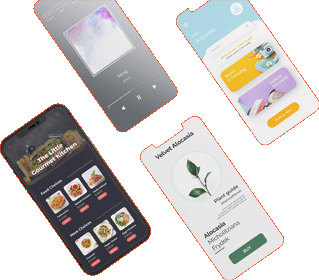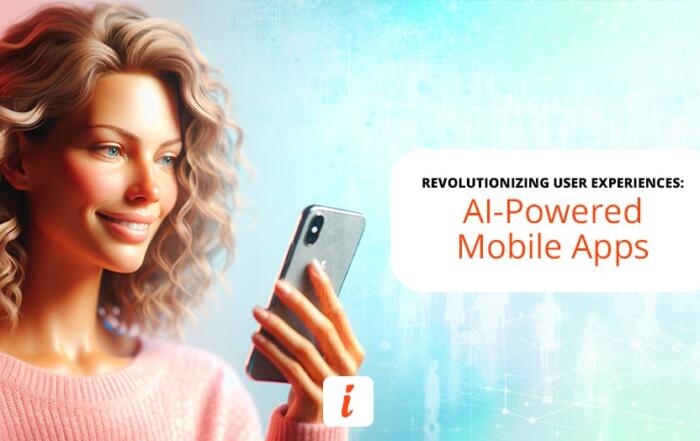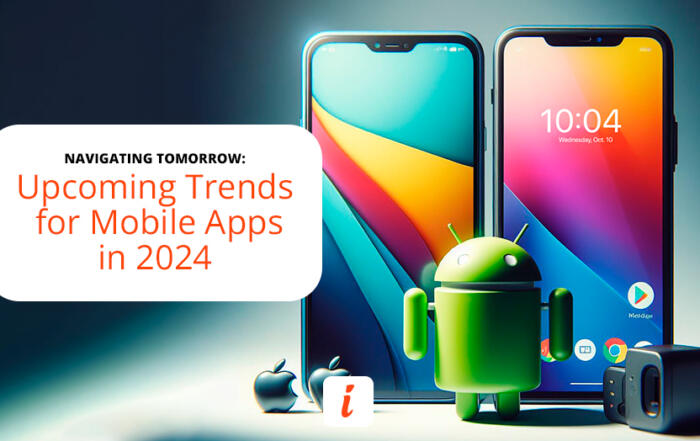Upcoming Trends for Mobile Apps
| By Inspire Visual Updated January 2025 |
The latest release of Android 14 on October 4, 2023, and iOS on September 18, 2023, introduce a slew of new features and functionalities available to mobile app users. The two most popular operating systems today add even more versatility to our digital versions of the Swiss army knife. That also means new trends are coming.
If you are planning on building an app or already have one, be sure your app developer knows how to get the most out of the new features while being aware of the limitations. For example, with Google’s focus on security in Android 14, it is no longer possible to install old apps as was the case in Android 13. So, if you haven’t updated your app since Android 5.1 Lollipop’s release in 2015, it’s time to call your mobile app developer.
From the integration of cutting-edge technologies to a heightened emphasis on privacy and sustainability, the upcoming year promises to be a pivotal one for mobile app owners.
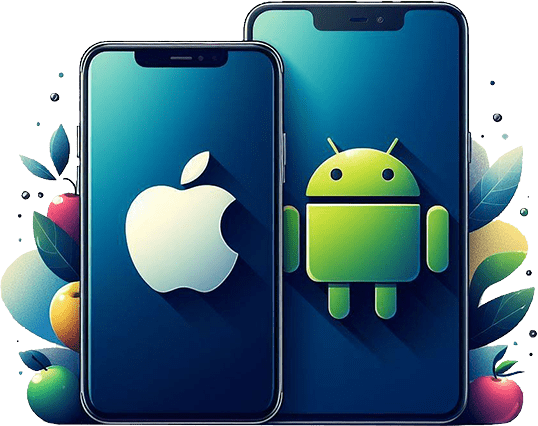
1. AI-driven personalization

2. Augmented Reality (AR) integration
Augmented Reality, once relegated to the realm of gaming and entertainment, is expanding its footprint across various industries. There were baby steps to use the AR technology in 2023, however, we can expect a surge in AR integration within mobile apps, transcending traditional boundaries.
Industries such as retail, education, and healthcare are poised to harness the potential of AR to offer users immersive and interactive experiences. Apple started toying with AR for AppleTV and mobile phones in 2017, the same year Google provided its SDK to build AR experiences.
Better immersion and integration with the real world
Imagine trying of clothes virtually before making an online purchase, visualizing furniture in your living room through your phone, or even undergoing medical training through realistic AR simulations. The possibilities are vast, and mobile apps are at the forefront of this AR revolution.
The implications for mobile apps are profound, enhancing user experiences across various industries.
- Enhanced Visualization in Retail: AR integration in retail apps allows users to visualize products in their real-world environment before making a purchase. From trying on virtual clothes to placing furniture in their living rooms, users gain a more immersive and informed shopping experience.
- Interactive Gaming Experiences: Mobile gaming is transformed with AR, creating interactive and location-based experiences. Games like Pokémon GO pioneered this trend, encouraging users to explore their surroundings while interacting with virtual elements superimposed on the real world through their mobile screens.
- Educational Applications: AR brings learning to life by overlaying educational content on physical objects. Educational apps can use AR to provide interactive anatomy lessons, historical tours, or astronomy experiences, making learning engaging and memorable.
- Innovative Navigation Solutions: Navigation apps benefit from AR by superimposing directions and points of interest directly onto the user’s real-world view. This enhances navigation efficiency, particularly for pedestrians, as they receive visual cues overlaid on the streets they are walking.
- Immersive Social Media Experiences: AR filters and effects in social media apps enhance user-generated content by adding virtual elements to photos and videos. Users can transform their appearances, add virtual backgrounds, or overlay information, contributing to a more creative and engaging social media presence.
- Virtual Try-On Experiences: In the fashion and beauty industry, AR integration allows users to try on clothing, accessories, and makeup virtually. This feature not only enhances the online shopping experience but also reduces the likelihood of returns by enabling users to see how products will look on them before purchase.
- Training and Simulation: AR is increasingly being used in mobile apps for training and simulation purposes. From professional skills training to simulations in healthcare and manufacturing, AR provides a safe and realistic environment for users to practice and learn.
- Enhanced Marketing and Advertising: Brands leverage AR in mobile apps to create interactive and engaging marketing campaigns. AR ads allow users to visualize products in their own spaces or participate in immersive brand experiences, fostering a deeper connection between consumers and brands.
The advantage of augmented reality in mobile apps
AR integration in mobile apps opens up a world of possibilities, blurring the lines between the digital and physical realms. The technology not only enhances user engagement but also provides practical solutions across diverse industries.
As AR capabilities continue to advance, mobile apps incorporating this technology are poised to deliver increasingly sophisticated and immersive experiences, transforming how users perceive and interact with digital content.
3. 5G revolution
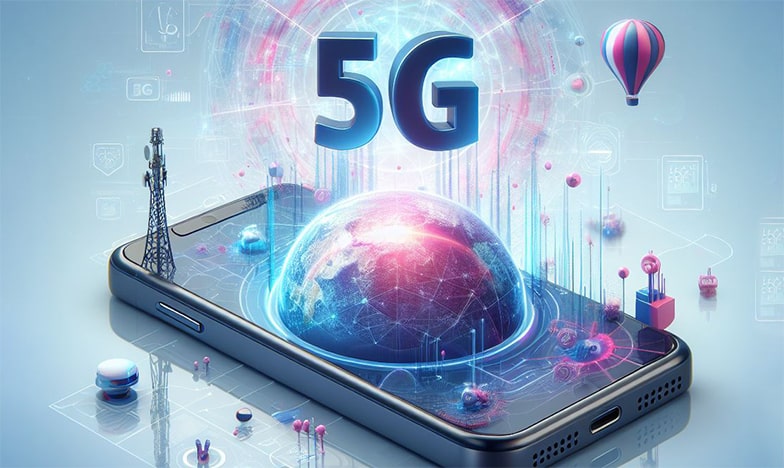
The advent of 5G technology marks a transformative era for mobile apps, ushering in a new wave of possibilities and capabilities. As the fifth generation of wireless technology, 5G offers significantly faster data speeds, lower latency, and increased network capacity compared to its predecessor, 4G. The implications for mobile apps are vast and cover various aspects of performance, functionality, and user experience.
What 5G technology means for mobile apps:
- Enhanced Speed and Responsiveness: The most noticeable impact of 5G on mobile apps is the dramatic increase in data speeds. Downloading and uploading content, streaming high-definition videos, and loading complex applications will occur almost instantaneously. This heightened speed translates to a more responsive and seamless user experience, reducing wait times and enhancing overall app performance.
- Real-time Collaboration: 5G’s low latency enables real-time communication and collaboration within mobile apps. Video conferencing, collaborative document editing, and multiplayer gaming can occur with minimal lag, fostering more interactive and engaging user experiences.
- Richer Multimedia Content: The increased bandwidth of 5G allows mobile apps to deliver richer multimedia content. From augmented reality (AR) and virtual reality (VR) applications to high-quality graphics and 3D models, 5G enables the seamless integration of advanced and data-intensive features, enhancing the visual and interactive elements of mobile apps.
- Improved Streaming Quality: Streaming services, such as video and music platforms, benefit significantly from 5G technology. Users can expect higher-quality streaming with minimal buffering, leading to a more enjoyable and uninterrupted media consumption experience.
- Advanced Augmented Reality (AR) and Virtual Reality (VR): AR and VR applications will reach new heights with the capabilities of 5G. The low latency and high data speeds enable more immersive AR experiences, such as real-time information overlays and interactive visualizations. VR applications, which demand significant data transfer for realistic simulations, will benefit from 5G’s enhanced bandwidth.
- Internet of Things (IoT) Integration: 5G’s increased capacity and low latency facilitate the integration of IoT devices with mobile apps. From smart home applications to industrial IoT solutions, 5G enables more efficient communication between devices, leading to improved automation, monitoring, and control.
- Gaming Revolution: Mobile gaming experiences will be revolutionized by 5G. Gamers can expect faster download times for large game files, reduced latency for responsive gameplay, and the ability to engage in high-quality multiplayer experiences on the go. Cloud gaming services will also flourish, as 5G can handle the streaming of graphically intensive games with minimal latency.
- Edge Computing Opportunities: 5G’s combination with edge computing allows processing to occur closer to the end user, reducing latency even further. This opens up opportunities for mobile apps to leverage edge computing for tasks that require real-time processing, such as AI-driven applications and critical data analytics.
5G opens a new world of opportunities as it expands
While 5G technology promises a myriad of benefits for mobile apps, it’s essential to note that widespread adoption and infrastructure development are ongoing processes.
As the global rollout of 5G networks progresses, mobile apps will continue to evolve, leveraging the full potential of this transformative technology to deliver enhanced user experiences and unlock new possibilities for innovation.
4. Voice-activated interfaces
Voice-activated interfaces have been on the rise, and we can expect this trend to solidify further.
Following proven best practices for UI design is going to work hand-in-hand with Natural Language Processing (NLP) to empower mobile apps to understand and respond to user commands, making tasks more hands-free and efficient.
The integration of voice commands will extend beyond virtual assistants, impacting navigation, content search, and even smart home integration.
Keep your eyes on the road, not the mobile phone
Imagine a future where users can control and navigate their apps entirely through voice commands, from sending messages to conducting complex searches. This trend aligns with the growing desire for seamless and intuitive user experiences.
- Hands-Free Operation: The primary advantage of voice-activated interfaces is the liberation from manual input methods. Users can perform various tasks within mobile apps simply by speaking commands, whether it’s sending messages, making calls, or initiating app-specific actions. This hands-free operation is particularly valuable in scenarios where manual interaction might be impractical, such as while driving or cooking.
- Enhanced Accessibility: Voice-activated interfaces contribute significantly to enhancing accessibility for users with disabilities. Those with limited mobility or visual impairments can navigate and interact with mobile apps more seamlessly through voice commands, promoting a more inclusive digital environment.
- Efficient Information Retrieval: Voice search capabilities within mobile apps streamline information retrieval. Users can verbally articulate their queries, and the app’s voice recognition system translates spoken words into actionable commands, enabling quick access to relevant information without the need for manual typing.
- Natural Language Processing Improvements: Advancements in natural language processing make voice-activated interfaces more adept at understanding context, intent, and colloquial language. Mobile apps can interpret nuanced commands, leading to more accurate and contextually relevant responses, thereby enhancing the overall user experience.
- Contextual App Interaction: Voice commands enable users to interact with apps more contextually and conversationally. For example, users can ask a weather app about the forecast, inquire about upcoming events in a calendar app, or dictate and edit text in a note-taking app, all through natural language interactions.
- Voice-Driven Personal Assistants: Mobile apps with voice-activated interfaces often integrate virtual assistants, such as Siri, Google Assistant, or Alexa. These assistants can perform a range of tasks, from setting reminders and sending messages to providing weather updates and controlling smart home devices, offering users a centralized and voice-driven hub for various activities.
- Reduced Screen Dependency: Voice-activated interfaces contribute to reducing users’ dependency on screens, especially in situations where hands and eyes are occupied. This shift is particularly valuable as mobile devices become integral to daily life, allowing users to multitask and access information without the need for direct physical interaction.
- Voice-Enabled App Automation: Mobile apps can leverage voice commands to enable automation features. Users can create voice-activated workflows, trigger specific app functions, or set up custom voice commands to execute sequences of actions within an app, enhancing efficiency and customization.
Voice-activated app challenges
However, the adoption of voice-activated interfaces also brings challenges, including privacy concerns, accuracy issues in noisy environments, and the need for careful design to ensure a seamless and intuitive user experience.
With the right app developer, it can be done right
As technology continues to evolve, the integration of voice-activated interfaces into mobile apps will likely become more refined, offering users an increasingly natural and sophisticated means of interacting with their digital devices.
How well it is done depends on choosing your best app development partner.
5. Privacy and security enhancements

As technology advances, so do concerns about data privacy and security. Mobile apps are expected to place an even greater emphasis on safeguarding user data.
Apple is still leaping ahead of Google in the privacy aspect as harvesting user behavior is a core part of Google’s business model. For both companies, encryption standards will be strengthened, and biometric authentication methods will become more sophisticated, providing an extra layer of security.
Privacy and security transparency bring a competitive edge to app owners
Moreover, app developers will focus on improving transparency regarding data usage, and users can anticipate more granular control over app permissions.
Apps that prioritize privacy and security will likely gain a competitive edge, as users become increasingly discerning about the protection of their personal information.
As technology advances, mobile apps are becoming more sophisticated in implementing measures to safeguard user information, ensuring trust, transparency, and a heightened level of user control.
The top 10 privacy and security must-dos:
- Enhanced Encryption Standards: Privacy and security enhancements entail the implementation of robust encryption protocols to protect sensitive data during transmission and storage. Advanced encryption algorithms ensure that unauthorized parties cannot access or intercept users’ personal information, significantly bolstering the overall security of mobile apps.
- Biometric Authentication: Mobile apps are increasingly adopting biometric authentication methods, such as fingerprint recognition, facial recognition, or iris scanning. These technologies provide an additional layer of security, making it more challenging for unauthorized users to gain access to the app or sensitive data within it.
- Two-Factor Authentication (2FA): Two-factor authentication adds an extra layer of protection by requiring users to provide two forms of identification before accessing their accounts. This commonly involves a combination of something the user knows (password) and something the user possesses (e.g., a temporary code sent to their mobile device).
- Secure App Permissions: Apps are enhancing user control over their data through more granular app permission settings. Users can specify which features and data the app can access, ensuring that only necessary information is shared and minimizing the risk of unauthorized data collection.
- Privacy by Design: Privacy considerations are integrated into the development process from the outset, following the principle of “privacy by design.” Developers proactively assess potential privacy risks and incorporate measures to mitigate these risks throughout the app’s lifecycle, promoting a privacy-centric approach to app development.
- Transparent Data Practices: Mobile apps are adopting transparent data practices by providing users with clear and understandable information about how their data is collected, used, and shared. Privacy policies are more accessible, and developers are striving for plain language to ensure users are well-informed about the app’s data handling practices.
- Regular Security Audits and Updates: App developers conduct regular security audits to identify and address vulnerabilities. Timely updates and patches are released to fix security flaws, ensuring that the app remains resilient to emerging threats and providing users with a secure environment for their interactions.
- User Education and Awareness: Mobile apps are increasingly focusing on user education to enhance privacy awareness. Through in-app notifications, tips, and educational content, users are informed about best practices for securing their accounts, recognizing phishing attempts, and understanding the importance of privacy settings.
- App Sandboxing: Mobile apps are often designed with sandboxing techniques, where each app operates within its own confined space, isolated from the rest of the device’s system. This prevents unauthorized access to other apps and the device’s core functionalities, enhancing overall security.
- Anonymous and Aggregate Data Collection: In instances where data collection is essential, apps are moving towards anonymous and aggregate data collection methods. This ensures that individual user identities are protected, and data is used in a way that respects user privacy while still providing valuable insights.
Build trust with your users
By prioritizing privacy and security enhancements, mobile apps aim to build user trust and confidence. The implementation of these measures not only protects users from potential risks but also aligns with evolving regulatory frameworks that emphasize the importance of user privacy in the digital landscape.
As mobile technology continues to advance, maintaining a balance between innovation and user protection becomes integral to the long-term success and sustainability of mobile apps.
6. Blockchain integration

Beyond the realm of cryptocurrencies, blockchain technology is set to make significant inroads into mobile applications. Blockchain’s inherent features of decentralization, immutability, and transparency will be harnessed to enhance security and traceability in various applications across iOS and Android devices.
Blockchain enhances privacy, security, and mobile user trust
Expect to see blockchain implementations in mobile apps for secure transactions, identity verification, and supply chain management.
The decentralized nature of blockchain aligns with the growing demand for secure and transparent digital interactions, paving the way for a more trustworthy mobile app ecosystem.
Here’s a breakdown of what blockchain integration means for mobile apps:
- Enhanced Security and Immutability: Blockchain’s decentralized ledger ensures the security and integrity of data. Mobile apps can leverage blockchain to create tamper-resistant records and transactions. Once data is recorded on the blockchain, it becomes nearly impossible to alter, providing an additional layer of security against data manipulation and unauthorized access.
- Transparent and Trustworthy Transactions: Blockchain enables transparent and traceable transactions within mobile apps. This is particularly valuable in financial apps or e-commerce platforms, where users can verify transactions and track the flow of funds in real time. The transparency of the blockchain instills a sense of trust among users, reducing the need for intermediaries in financial transactions.
- Smart Contracts for Automation: Smart contracts, self-executing contracts with the terms of the agreement directly written into code, can be integrated into mobile apps through blockchain technology. This allows for automated and trustless execution of agreements, eliminating the need for intermediaries and reducing the risk of fraud or disputes.
- Decentralized Identity and Authentication: Blockchain integration enables decentralized identity management, reducing reliance on central authorities for user authentication. Users can have more control over their identity, and apps can implement secure, blockchain-based authentication mechanisms, mitigating the risks associated with centralized user databases.
- Tokenization of Assets and Rewards: Mobile apps can utilize blockchain for tokenization, representing assets or rewards within the app ecosystem. This can include in-app currencies, loyalty points, or even tokenized ownership of digital assets. Users can have verifiable ownership, transferability, and interoperability of these digital assets.
- Immutable Data Storage: Blockchain provides a decentralized and immutable data storage solution. Mobile apps can utilize blockchain to store critical data, ensuring its permanence and reducing the risk of data loss or manipulation. This is particularly valuable for applications where data integrity is paramount, such as healthcare or legal services.
- Cross-Border Payments and Remittances: Blockchain facilitates seamless cross-border payments and remittances by eliminating intermediaries and reducing transaction costs. Mobile apps can leverage blockchain to enable users to send and receive payments globally securely and efficiently.
- Supply Chain Traceability: Blockchain integration in mobile apps can enhance supply chain management by providing a transparent and traceable record of the journey of products from origin to destination. This is especially crucial for industries like food and pharmaceuticals, where traceability and authenticity are critical.
- Crowdfunding and Token Sales: Blockchain allows for decentralized fundraising through Initial Coin Offerings (ICOs) or Security Token Offerings (STOs). Mobile apps can integrate blockchain to facilitate crowdfunding campaigns or token sales, providing a decentralized and transparent means for project funding.
- Privacy Protection and Data Ownership: Blockchain enables users to have greater control over their data. By integrating blockchain, mobile apps can implement privacy-centric features, allowing users to control access to their personal information and decide how their data is shared and used within the app ecosystem.
Pay attention to best-case scenarios for each mobile app
While blockchain integration presents numerous opportunities, it’s essential to consider the specific use case and user experience.
The technology is continuously evolving, and as mobile apps explore the potential of blockchain, developers must navigate the balance between innovation, usability, and adherence to regulatory frameworks.
As the blockchain space matures, the integration of this technology is likely to reshape how Android and iOS mobile apps operate and interact with users in a decentralized and secure manner.
7. Extended reality (XR)
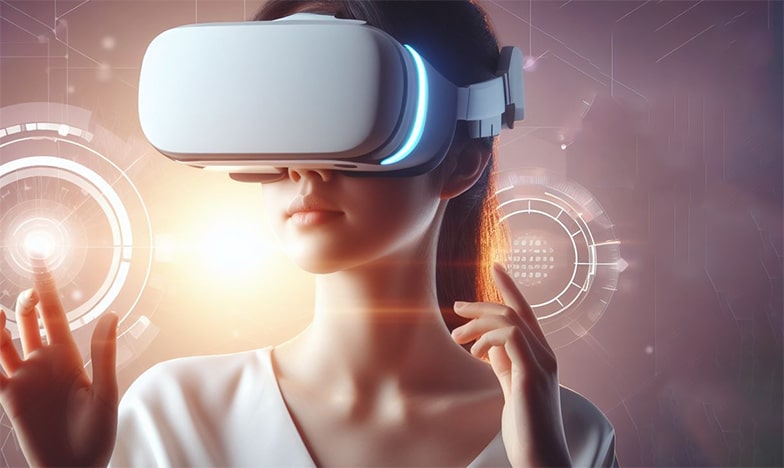
Extended Reality (XR) represents a spectrum that includes Virtual Reality (VR), Augmented Reality (AR), and Mixed Reality (MR), and its integration into mobile apps is reshaping the way users interact with digital content.
XR goes beyond traditional boundaries, creating immersive and interactive experiences that blend the digital and physical worlds.
It will be a milestone for XR technology
Mobile apps will leverage XR technologies will not only redefine entertainment experiences but will also find applications in education, healthcare, and professional training. The blurring of lines between the physical and virtual worlds opens up a plethora of possibilities for innovative mobile app development.
Extended Reality will benefit:
- Virtual Reality (VR) Experiences: VR immerses users in entirely virtual environments. Mobile apps that integrate VR can provide users with immersive gaming experiences, virtual tours, and training simulations. By using VR headsets or simply the smartphone screen, users can step into a virtual world that responds to their movements and interactions.
- Augmented Reality (AR) Integration: AR overlays digital content onto the real-world environment seen through the mobile device’s camera. Mobile apps with AR features enhance users’ surroundings by adding virtual elements. This can include anything from information overlays in navigation apps to interactive product demonstrations in retail apps.
- Mixed Reality (MR) Experiences: MR combines elements of both VR and AR, allowing digital and physical objects to coexist and interact in real time. Mobile apps with MR capabilities create experiences where virtual objects appear seamlessly integrated into the user’s physical environment, enabling a new level of interactive and dynamic content.
- Immersive Training and Simulation: XR in mobile apps is revolutionizing training and simulation scenarios. From virtual job training to medical simulations, XR allows users to engage in realistic, risk-free environments where they can practice and enhance their skills.
- Enhanced Gaming Experiences: Mobile gaming experiences are elevated with XR. Users can immerse themselves in virtual worlds, interact with characters and objects in their physical space, and even engage in multiplayer AR or VR games that blend the real and virtual realms.
- Virtual Meetings and Collaboration: XR transforms how individuals collaborate remotely. Mobile apps integrating XR enable users to conduct virtual meetings where participants feel physically present in the same space. This goes beyond traditional video conferencing, providing a more immersive and engaging collaborative experience.
- Virtual Travel and Exploration: XR in travel apps allows users to virtually explore destinations before deciding to visit. Whether it’s a 360-degree tour of a hotel room or a virtual walkthrough of tourist attractions, XR enhances the travel planning experience by providing a more immersive preview.
- Educational Applications: XR has immense potential in education. Mobile apps can use AR to provide interactive lessons, allowing students to visualize complex concepts, historical events, or scientific phenomena. VR, on the other hand, enables virtual field trips and immersive educational experiences.
- Interactive Product Demonstrations: Retail and e-commerce apps leverage XR to provide interactive product demonstrations. Users can virtually try on clothing, visualize furniture in their homes, or even see how makeup products look on their faces before making a purchase.
- Healthcare Training and Simulation: XR is transforming healthcare training by offering realistic simulations for medical professionals. Mobile apps provide virtual surgeries, anatomy explorations, and other medical scenarios, allowing practitioners to enhance their skills in a risk-free environment.
- Enhanced Storytelling and Entertainment: XR enhances storytelling in mobile apps, providing users with immersive narratives and interactive elements. From AR-enhanced books to VR cinema experiences, XR adds a new dimension to entertainment and storytelling.
XR is reshaping the mobile app landscape
As XR technology continues to evolve, its integration into the development of Android and iOS mobile apps holds the promise of unlocking even more innovative and diverse experiences.
From entertainment and education to healthcare and beyond, XR is reshaping the landscape of mobile applications, offering users a new level of engagement and interaction with digital content.
Conclusion
It is set to be a transformative one for the mobile app industry, marked by a convergence of cutting-edge technologies and a heightened focus on user experience, privacy, and sustainability.
From the infusion of AI-driven personalization to the tangible impact of 5G connectivity, mobile apps will continue to evolve, reshaping how we live, work, and play.
The main factors for how much it is going to cost to build your mobile app depend on the complexity, number of screens, and devices you are targeting. We can help by providing a free estimate based on your needs.
The exciting future of mobile apps
As users, developers, and businesses adapt to these trends, the mobile app ecosystem will undoubtedly become more sophisticated, intuitive, and responsive to individual needs.
Navigating the landscape of mobile apps will be an exciting journey, defined by innovation, user-centric design, and a commitment to a future where technology seamlessly integrates with our daily lives.
Now, let’s talk about your app and how we can get it ready. We have extensive experience developing for both iOS, Android or cross-platform apps. We build apps for mobile, tablet, smartwatches, and more. Let’s get started.

About Inspire Visual
At Inspire Visual, we believe that compelling design, functionality and content help drive effective results. That’s why we work hard to provide innovative, visually inspiring and functionally sound solutions to address your marketing challenges and extend your brand’s reach.
We offer decades of experience helping brands worldwide with websites, mobile app development, email marketing, direct mail campaigns, brand identity design, UI/UX, graphic design, print design, tradeshow design and more. We feel privileged to be allowed into our clients’ businesses, and we strive to provide personal service and close collaboration throughout your project.
Call 407.434.9171 or email hello@inspirevisual.com to contact us, so we can meet you, learn more about your business and answer any questions you have. We’d love to connect with you!
YOU MAY ALSO LIKE
Revolutionizing User Experiences: AI-Powered Mobile Apps
Artificial Intelligence (AI) is impacting how we interact with technology on a daily basis. Find out which five AI apps are the most powerful today and how they can help improve your life.
Navigating Tomorrow: Upcoming Trends for Mobile Apps
In 2024, mobile apps are poised to undergo a transformative evolution with several key trends shaping the landscape. Get first-hand knowledge of what is to come and what to include in your app.
Are you ready to talk about your project?

Hello, I’m Angela, co-founder of Inspire Visual! Let’s have a chat about your project. Send an email or fill out the form to get started. Talk soon!

